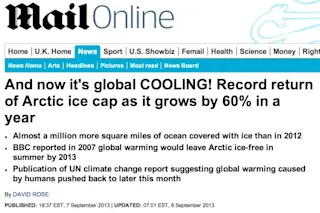A screenshot of the top of a global warming story in The Mail yesterday. The headline and bullet points above accompanied a story over the weekend by David Rose in the U.K. newspaper the Mail. It now seems to be gaining traction elsewhere in the media, including in a story in the Telegraph (which seems to be largely copied from the Mail), and this item on MSN Now. Let us count the ways that the headline and story violate the principles of journalism I will be discussing with 130 eager young undergraduates this afternoon in a class I teach at the University of Colorado. Literally. That's the purpose of this piece. Rose writes the following at the top of his story:
A chilly Arctic summer has left nearly a million more square miles of ocean covered with ice than at the same time last year – an increase of 60 ...














